LG G5 review: Bolder doesn't always mean better
The company's big comeback still feels like a work in progress.
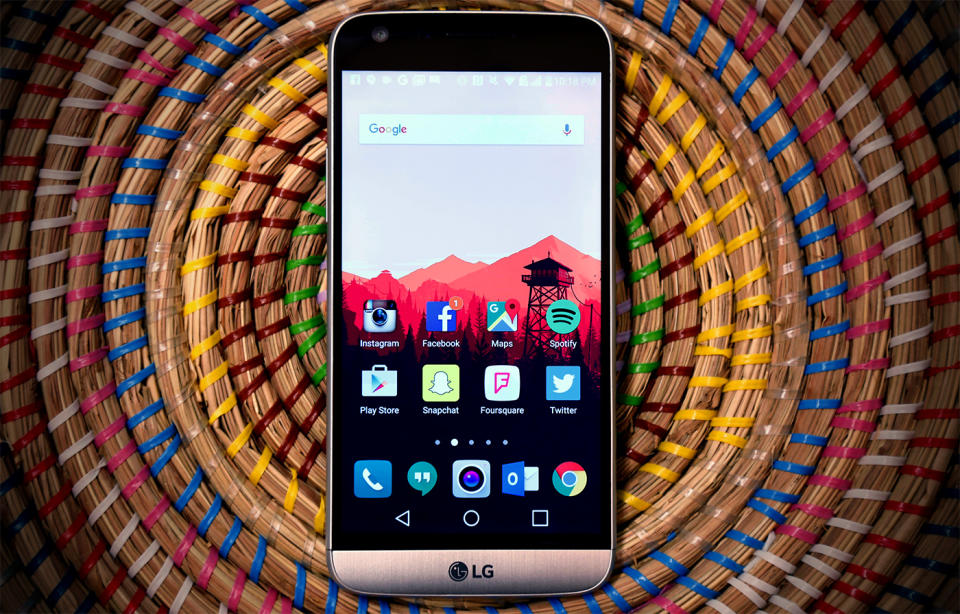
LG thinks it's time for a change. Rather than build just another thin, fast flagship, the company's latest work lets you augment it with purpose-built, snap-on accessories. Say hello to the G5, a phone with the potential to grow with you.
A lot of chutzpah went into LG's decision, and it's almost like LG had no choice but to be provocative: Recent figures indicate the company is still struggling to crack the upper tiers of the global smartphone market. To paraphrase a bit from the best television show of all time, ambition and overreaching are good. The problem is, LG had to somehow build a smartphone that's both functional and powerful now and easy to improve later. Alas, LG didn't quite clear the high bar it set for itself.
Hardware

The G5 might be the most ambitious flagship I've ever used, but you probably wouldn't guess that from its looks. "Boring" is the single most common adjective I've heard used in conversation to describe the phone's design. And that's understandable; physically, there's just not a lot going on here. For what it's worth, I personally find the G5 kind of charming. Its all-metal body is softened by rounded corners and a curved glass forehead that also houses the earpiece and an 8-megapixel selfie camera. The device is pleasant to hold too, though I'd still give the comfort nod to the Galaxy S7, which is actually a hair thicker than the G5. Throw in a Snapdragon 820 chip, 4GB of RAM, a 5.3-inch IPS LCD display running at Quad HD resolution and a USB Type-C port on the bottom and you've got yourself a solidly modern (if forgettable) phone.
Peer a little closer, though, and you'll start to see key signs that not all is normal here. LG broke with tradition by moving the phone's volume keys to the left side, instead of fitting them above and below the rear power button/fingerprint sensor. (That sensor, by the way, seems much more finicky than the one on the Nexus 5X.) Meanwhile, the signature lump on the back plays host to not one but two cameras: one for wide-angle shots and another for your more traditionally framed photos. Additionally, there's one more button on the G5's left edge; pressing it releases a latch and frees the phone's battery/chin-piece combination. Congrats! You've found what makes the G5 such a marvelously crazy phone.
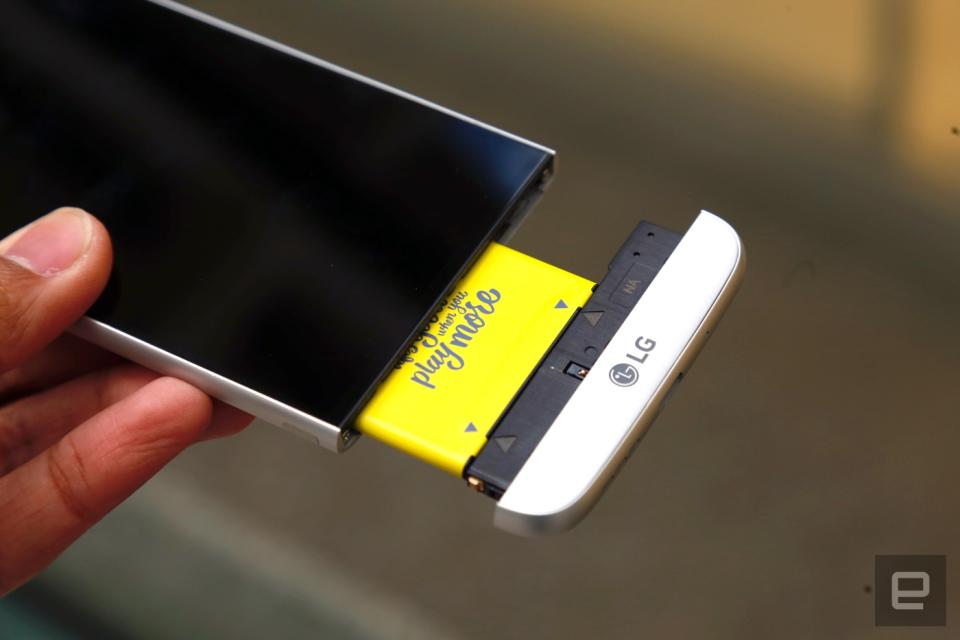
You'll be doing this a lot if you want to swap between your G5's additional "Friend" modules, and the process can involve a certain amount of terror. See, swapping Friends sometimes involves removing the G5's 2,800mAh battery from one module and snapping it onto another. The best way I've found is the "removing a Band-Aid" approach -- a quick, decisive jerk while holding the battery in your left hand and the module in your right. Don't think about it -- just do it. It took me a good 15 minutes to figure out the process, because I was so worried I'd break something, but so far I've managed to avoid destroying either of our review loaners. Still, I'm curious about how long these things will last before some poor piece of plastic snaps. Beyond that, I'm frustrated that the G5 doesn't have some tiny auxiliary battery inside so that it doesn't have to restart every time you want to start using the camera grip or the audio DAC.
The G5's modular ambitions are lofty, but there are some obvious sacrifices that had to be made to get them all working. There's a pretty noticeable gap between the bottom of the screen and the top of the phone's chin, which doesn't exactly do much for the G5's fit and finish. LG obviously couldn't make this thing modular and waterproof, so be sure to keep the G5 away from your toilet. At least we still have some of LG's long-held niceties, like a microSD card reader (you can add on up to 2TB of additional storage) and a surprisingly handy IR blaster.
Display and sound
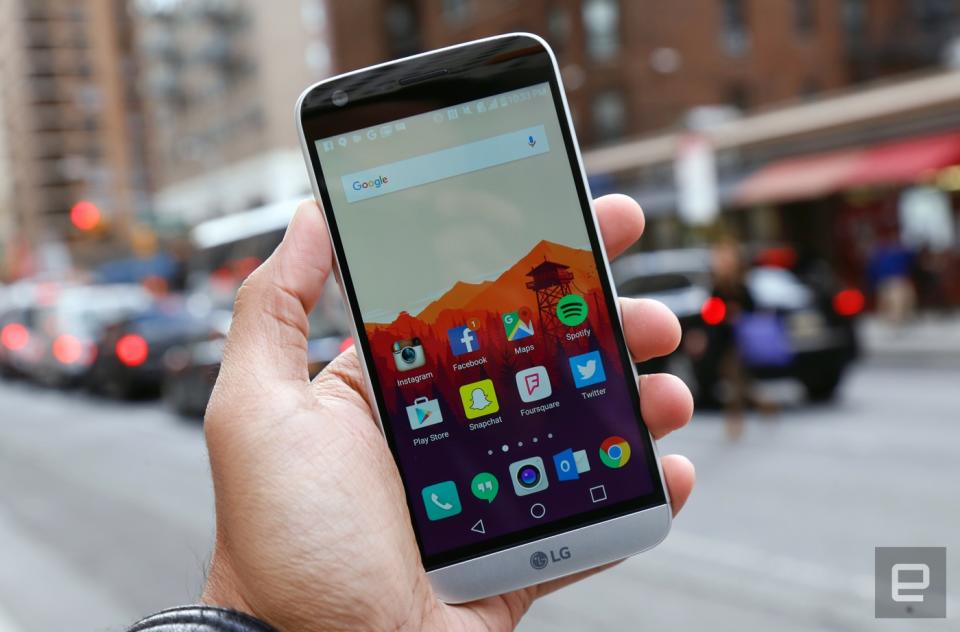
Last year, the G4 gave us our first look at LG's so-called Quantum displays -- screens that sought to portray a wider, more accurate color gamut. LG didn't rewrite the book with the 5.3-inch IPS screen on this year's G5; it just improved a few things here and there. First off, the smaller Quad HD display makes the device a little easier to hold, and it's a hair sharper as well: It has a pixel density of 554 ppi, while the G4's 5.5-inch screen had 538 pixels per inch. The G5's display is a little brighter too, which will certainly come in handy as we head into summer. Images look the same here as they do on the G4, but, accuracy claims aside, colors still lack the sort of punchy, visceral appeal you'll get on rival devices. Hues here feel subdued and understated, but hey, that might be your thing -- and for my part, I got used to them quickly enough.
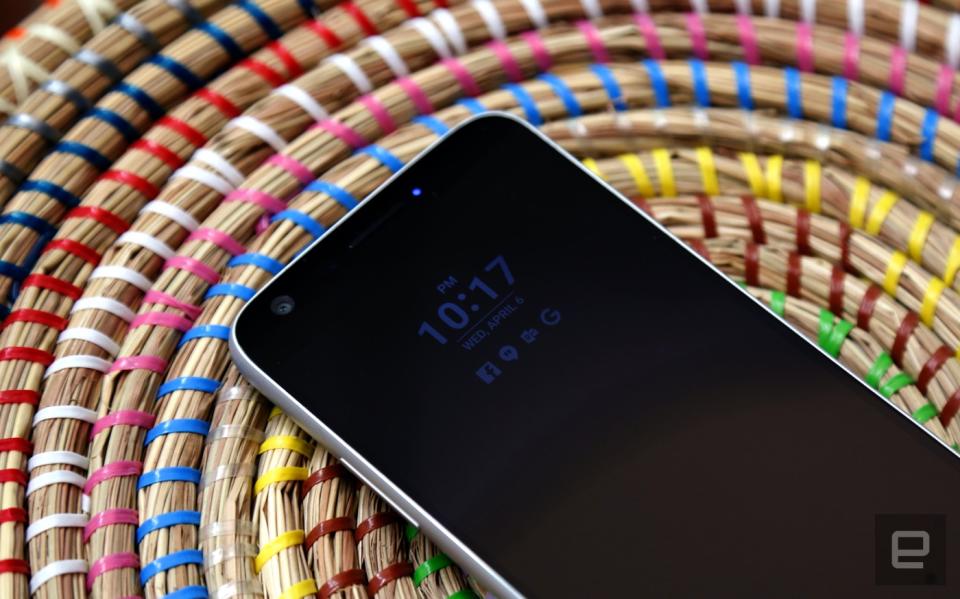
The G5's screen also has an always-on mode, inspired by the secondary display on last year's V10. It's impossible to dodge comparisons between the G5 and the approach Samsung took with the Galaxy S7 family, but it ultimately comes down to personal preference. Quick recap: The G5 uses an LCD screen, and you can't light up just part of it like you can with a Galaxy's AMOLED display. That means the G5's entire screen is lit up (if only a little), which can make it somewhat distracting in the dark. LG's approach is valuable, since it displays notifications from all your apps, not just a select few. Most important, it manages to tax the battery less than the GS7's always-on screen did.
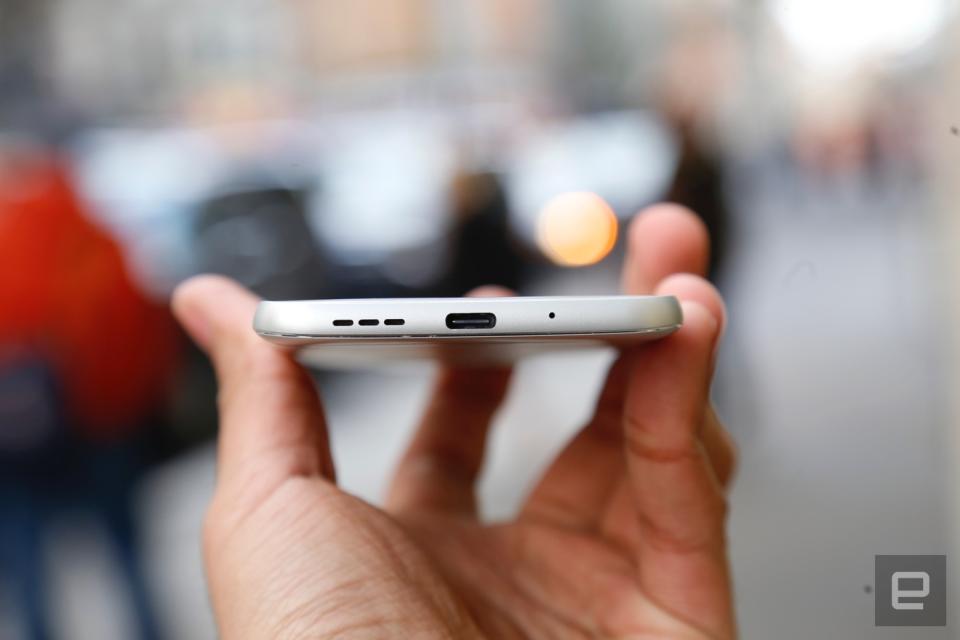
Meanwhile, the G5 has a single speaker wedged into its bottom, and it's one of the better ones through which I've listened to My Brother, My Brother and Me lately. It's surprisingly loud and does a fine job keeping the soundstage clear. You'll need some headphones (and maybe one of LG's HiFi audio modules) for long-term listening, but the G5 is a more capable audio machine out of the box than you might expect.
"Friend" modules
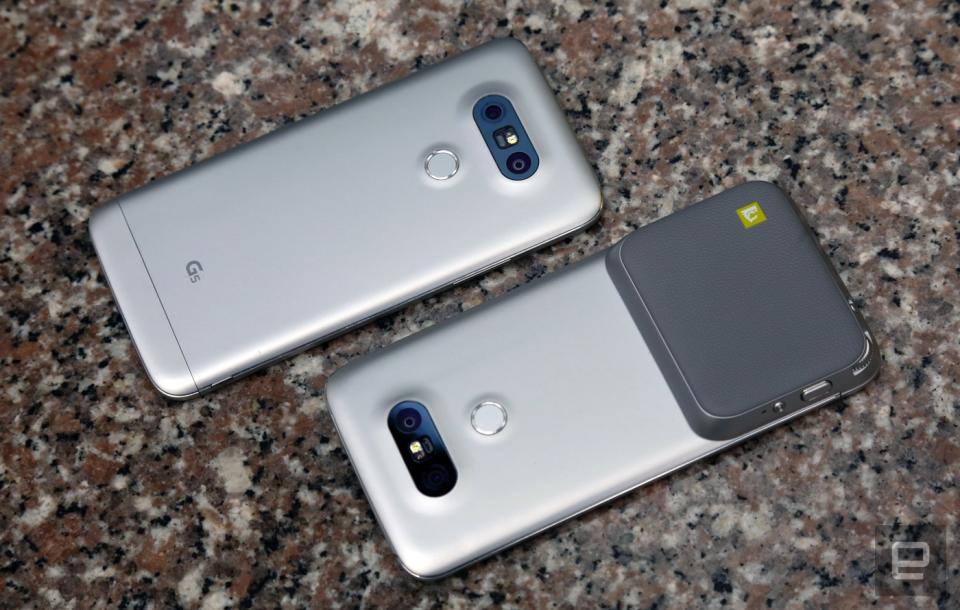
As far as LG is concerned, the G5 isn't just a flagship -- it's a foundation for a new kind of phone experience. With a little help from its Friends (in this case, an eclectic mix of accessories), the G5 could offer a better camera experience, or the sort of sound quality audiophiles have been dreaming of. By virtue of its modular design, the G5 could become the right smartphone for any situation! Other companies have talked up the promise of modular smartphones for years now, but LG is the first major player to bring that taste of flexibility to the masses. That's enough to earn some kudos from me, but here's the rub: None of the Friends I've used so far make the G5 significantly better.
Take the $70 LG Cam Plus, a chunky grip that gives the G5 physical camera controls and an extra 1,200mAh worth of juice. Having a secondary battery and a two-stage shutter button is nice, but it's otherwise forgettable as a camera accessory. And in addition to being awkwardly positioned on the grip's corner, the zoom dial doesn't have any tension or friction -- which makes it lousy for precision zooming. It's far from terrible, but really, its biggest draw is the extra battery inside.
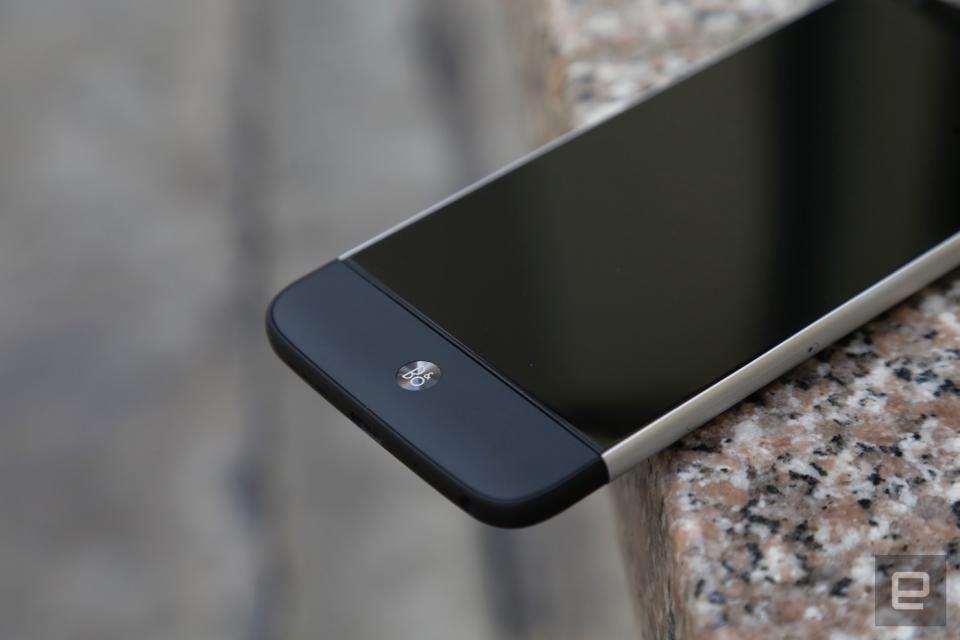
Then there's the Hi-Fi Plus module, which LG developed in tandem with Bang & Olufsen (and which doesn't seem to be coming to the US). Audiophiles will appreciate the fact that it upscales just about any audio -- be it from Spotify, YouTube, whatever -- to 32-bit quality. I'm currently on the hunt for the perfect earbuds, but none of the in-ears I tried with the Hi-Fi Plus sounded dramatically better than before. Best-case scenario, a track I had listened to hundreds of times in the past felt a little deeper. Other times, songs just sounded different. Not better, not worse, just different. In fairness, music buffs with more elaborate rigs will probably get more use out of this DAC than I did, especially since you can hook it up to other audio devices with an included cable.
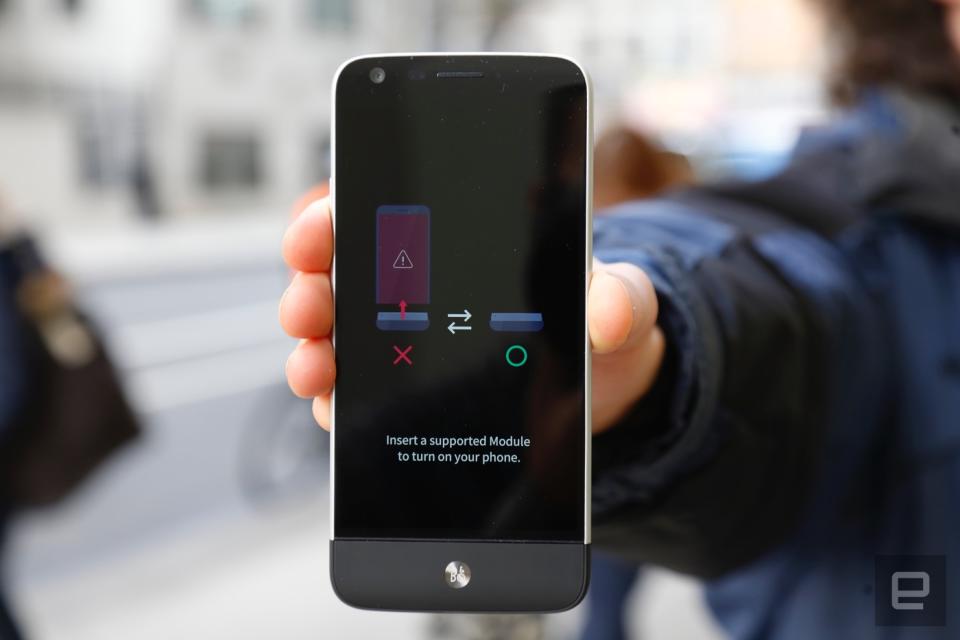
As it turns out, that cable would be crucial to my testing. See, the FCC hadn't certified this particular module, so it absolutely refused to work with my T-Mobile G5. I had to use the cable as a pass-through to even get the phone to boot normally, so please: Make sure you have all the facts before you buy a Hi-Fi Plus from overseas for your personal G5. This hiccup also raises some curious questions about the future of the Friends program: Will we see other modules launch only in certain markets? And will they refuse to play nice with the US G5 too?
Obviously, this is just the tip of the iceberg for the G5's Friends. Two add-ons I've encountered in the past -- the curious VR headset and Rolling Bot -- will be ready for prime time soon. Still others, like LG's new Tone Bluetooth earbuds, don't excite much, since they work fine with any modern smartphone. Still, an ever-updating selection of Friends could mean the G5 is that rare device that actually gets better with time. What's more, LG has mentioned that it's opening its foundation to third-party modules, and Friends released for the G5 are expected to work with next year's flagship too. The only way to ensure LG's Friends have a future is to pay for existing ones, and no one could blame you for being hesitant right now.
Software
The G5 ships with Android 6.0.1, and by now you're probably familiar with what Marshmallow brings to the table. (If not, be sure to check out our full review of the OS.) Standout features include Now on Tap, which offers extra context and information about whatever's currently on-screen. Separately, Marshmallow highlights app permission requests, so you'll always know what your software is trying to do. As always, LG has painted over Android with its custom LG UX, now at version 5.0. One of the company's big software priorities over the past few years has been to tone down its interface to let more of Google's work shine through, and indeed this year we're seeing LG's UX at its most restrained.
The most jarring tweak to the Android formula is the app launcher: It's gone by default. All your apps get splayed out across your home screens, iOS style. If that's a deal-breaker for you -- and I'm sure it will be for some -- your only options are to switch into LG's included "Easy Home" launcher or install a new one entirely.
The Smart Bulletin page that mashed features like LG Health, Calendar and the company's custom music player onto a single home-screen panel is off by default now. You can't have two apps running split-screen either, probably owing to the smaller screen here. (I never used it anyway, and I'm curious how many of you will actually miss it.) LG also ditched the G4's darker interface in favor of a white-and-teal color scheme.
To handle those myriad modules and add-ons, there's also a Friends Manager app that gives you a full list of the accessories currently connected to the phone (... as well as a link to LG's Friends store). My review unit was on T-Mobile, and so there were seven magenta-hued preload apps as well. Since you can't delete them, the best you can do is pop into the settings and disable them. Still, considering how some carriers go overboard with the bloatware, T-Mobile has a relatively modest bloatware load.
All told, I'm not sold on some of these changes, but I still appreciate LG's willingness to pare down on the software cruft that gets in the way while we're trying to do things. For those who liked the G4's software experience, you'll fall into the G5 routine very easily. If you didn't, though, nothing here is going to change your mind.
The cameras
When LG first revealed that the G5 would have two rear-facing cameras, I scoffed. It sounds like gimmick central, right? Well, this is the part of the review where I have to eat some crow. While not perfect, LG's dual-camera setup is actually one of its most valuable (and fun) features. The 8-megapixel camera is fitted with a wide-angle lens that gives you a 135-degree field of view. LG says that's slightly more than what your eyes can take in, making it a solid choice for spacious landscapes. Next to it is a more traditional 16-megapixel camera with an f/1.8 aperture lens -- a more suitable option for portraiture. It's hard to describe the differing results in words, but thankfully we've got some visual aids. Here's a shot from the National Zoo with the wide-angle camera:

And one with the traditional camera:

Switching between the two takes a single tap, but you can also pinch and expand to zoom in and out; zooming past a certain point makes the G5 switch cameras. Minor gripe: This "hybrid zoom" isn't seamless. There's about a one-second pause while the phone makes the switch. I suspect there wasn't much more LG could do to ease the transition. Don't worry, though: LG didn't lean on a gimmick to cover for some lousy cameras. The 16-megapixel camera is a very good shooter and the better all-around choice; it seems slightly more adept at saturating shots, and there's much more detail to be spotted.
It's too bad you can't get that same level of performance out of the wide-angle camera; photos are still bright, but softer and less nuanced than shots taken with its sibling. If nothing else, though, those wide shots are used to great effect by some of the G5's shooting modes: "Pop-out" overlays a narrow shot over a wide one, and "multi-view" mashes up photos taken with the front, narrow and wide cameras.

While having a pair of cameras affords smartphone photographers more flexibility in the field, the main 16-megapixel sensor doesn't usually fire off photos that are nicer to look at than shots snapped with a Galaxy S7. In more than a few cases, the G5 was slower than the GS7 at focusing and capturing images, which can be frustrating when trying to nab those crucial action shots. You can take matters into your own hands with the camera app's manual mode, but while there are plenty of settings to play with (white balance, ISO, shutter speed, etc.), most people probably won't bother.
Low-light performance is mostly respectable, though I'd still rather take the GS7 into a dive bar -- the G5's results were grainier, and moving subjects were more prone to ghosting. You can also shoot 4K video (making an additional microSD card a must for some), which usually came out well-saturated in bright situations. This is where the G5's optical image stabilization really comes in handy: It's good at smoothing out some of the jitters that come with on-the-go filming.
Performance and battery life
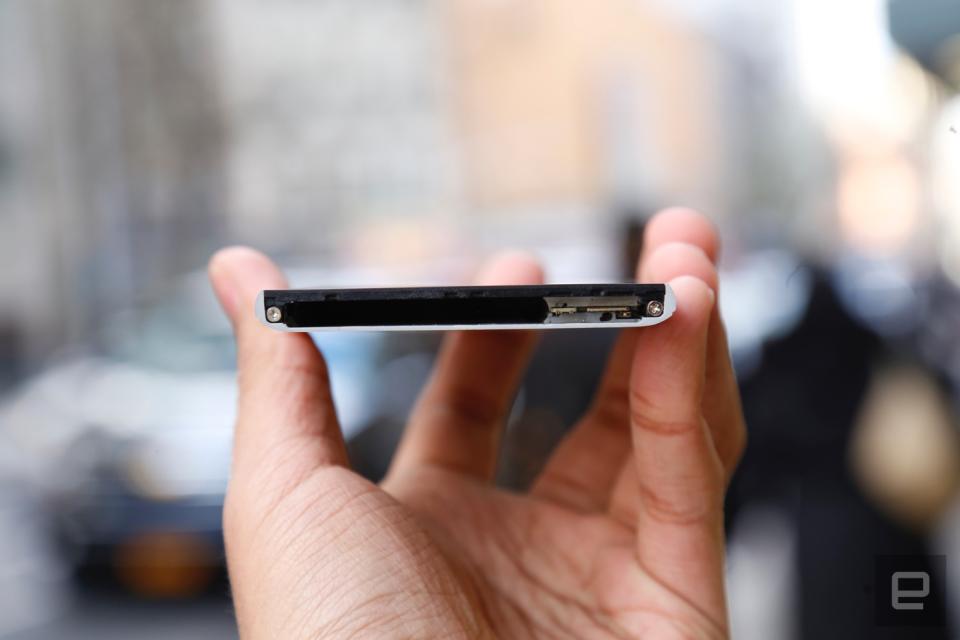
We're starting to see Qualcomm's quad-core Snapdragon 820 chipset pop up all over the place, and with good reason: It's a blazing-fast bit of silicon. Here it's paired with 4GB of RAM, and the results are just as snappy as you might expect -- maybe even snappier. Whipping through pages of apps is easy, as is actually launching them. Graphically intensive games like Asphalt 8, Dead Trigger 2 and Mortal Kombat X pose no issue for the G5 either. That's largely thanks to the high-powered hardware, but LG's relatively light touch with the software seems to help too. I noticed occasional pangs of slowness and stuttering while reviewing the Galaxy S7, but never with the G5.
If benchmarks are more your speed, well, have at them:
LG G5 | Samsung Galaxy S7 | Samsung Galaxy S7 Edge | LG G4 | |
|---|---|---|---|---|
AndEBench Pro | 14,152 | 14,168 | 13,030 | N/A |
Vellamo 3.0 | 4,104 | 4,285 | 4,152 | N/A |
3DMark IS Unlimited | 26,981 | 28,529 | 26,666 | 27,542 |
SunSpider 1.0.2 (ms) | 640 | 1547 | 942 | 220 |
GFXBench 3.0 1080p Manhattan Offscreen (fps) | 47 | 45 | 47 | 18.2 |
CF-Bench | 36,488 | 51,227 | 46,290 | N/A |
SunSpider 1.0.2: Android devices tested in Chrome; lower scores are better. | ||||
Alas, something had to give -- the G5 is purely middle of the road when it comes to battery life. Thankfully, what passes for middle of the road these days is still a big improvement over phones from a few years ago. The G5 routinely stuck around for full 12-hour workdays (complete with the requisite Slack messages, emails, podcasts and some occasional hotspot duty), with around 10 percent charge remaining.
Things were less peachy when it was time for our standard video rundown test. The G5 looped a 720p video with screen brightness set to 50 percent for ten and a half hours. That's slightly less than what I squeezed out of the G4 last year, and notably less than the 13-plus hours I got on the Galaxy S7. At least you can easily swap dead batteries for new ones, a feat that's nearly extinct in high-end phones. And even if you don't want to buy (or carry and keep track of) a separate battery, the G5 supports Qualcomm's QuickCharge 3.0 tech -- it'll get you from fully dead to 50 percent full in about 30 minutes.
The competition
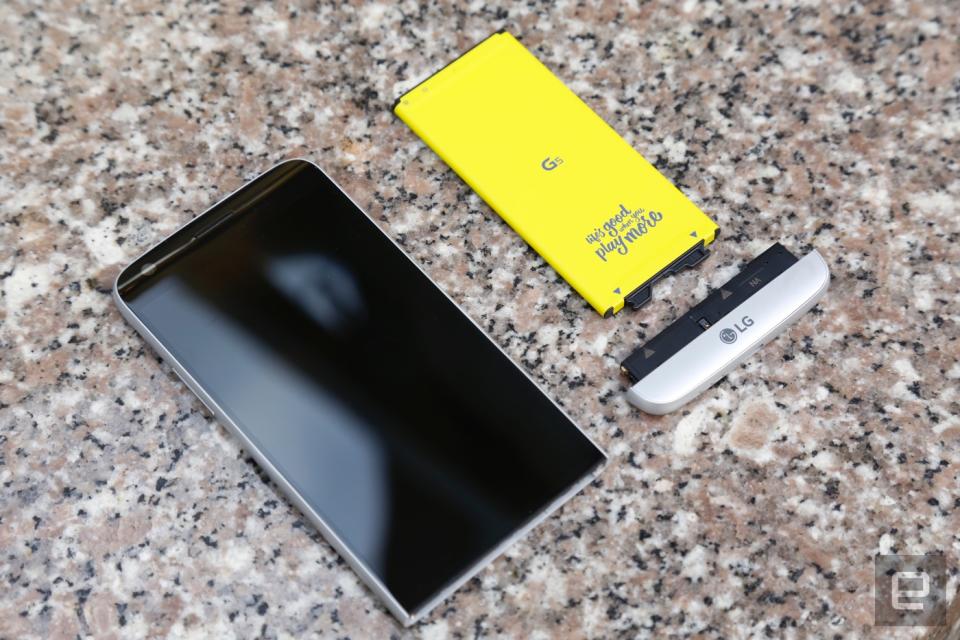
I've invoked the name several times already, but how could I not? Samsung's Galaxy S7 and S7 Edge are the G5's biggest competitors, and they're arguably the smarter choices if you don't care about swapping modules. They both have Snapdragon 820 chips and 4GB of RAM like the G5, not to mention more saturated screens, better battery life and sleeker designs. These are some seriously worthy packages, but the occasional performance hiccups (which seemed more prevalent on the S7 Edge) mean the G5 generally feels a little snappier.
The Nexus 6P is also a phenomenal option, and while it lacks some of the power seen in this new batch of flagships, its pure Android experience and first-rate build make the G5 seem unfocused by comparison. If you're intrigued by the G5's modular aspirations, though, there's not much else out there to scratch that itch. Google's Project Ara team has been awfully quiet lately, and the modular Fairphone 2 is meant only for use in Europe. Still, with its easy-to-disassemble body and respectable performance, the latter might be a fun choice for all you European tinkerers out there.
Wrap-up
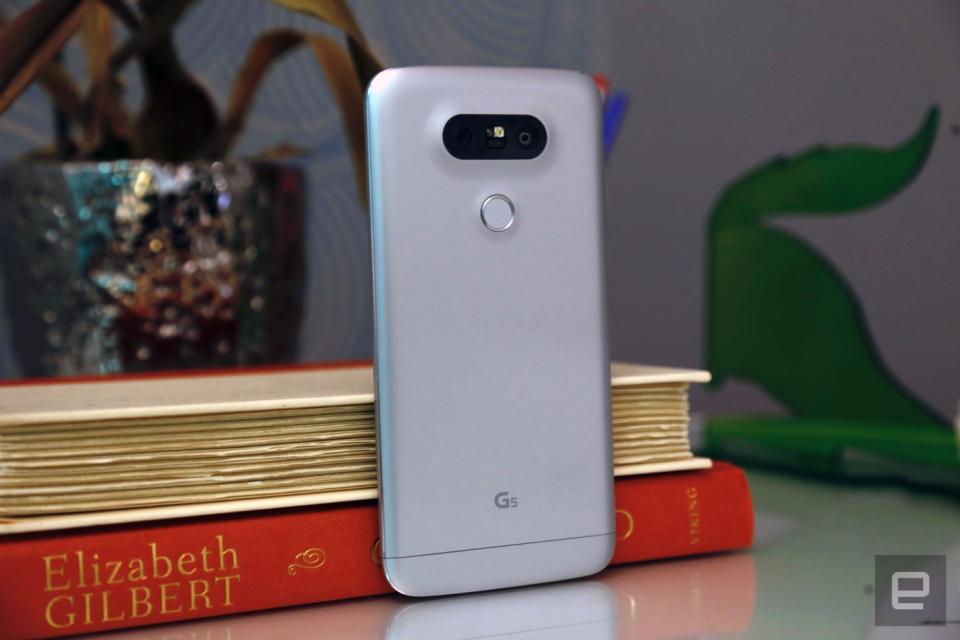
Let's be honest: Did the G5 ever really have a chance at living up to its own hype? Amid a sea of incrementalist competitors and me-too devices, LG's plan for a more or less modular smartphone was a lungful of fresh air. And I fell into the hype. After a week of testing, though, I'm stuck staring the reality of this phone dead in the eye.
The G5 isn't a bad device by any stretch: Its remarkable power makes the experience of using it surprisingly smooth, and I hope the dual-camera gimmick sticks around a little longer. Still, it feels like LG had to give up a lot of polish to make the G5 the sort of standout it wanted. And even then, the first batch of connectable modules wasn't really worth writing home about. If you're thinking about buying a G5, you'll probably find yourself weighing its current value versus its potential value. For some, the G5's ability to grow with extra hardware might be worth the trade-offs. For everyone else -- and this will be most people -- the G5 may be a little too bold for its own good.








































